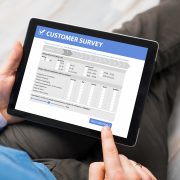BARE Shares – A Study of 46,000 Shoppers Shows That Omnichannel Retailing Works
‘Traditional retailers are feeling the heat. Even as competition intensifies, shoppers’ visits to retail stores are declining every year, leading one industry veteran to ominously ask his peers, “Is anyone not seeing large traffic declines?”’ Here, BARE International shares a study by Emma Sopadjieva, Utpal M. Dholakia, Beth Benjamin for Harvard Business Review on 46,000 Shoppers Shows That Omnichannel Retailing Works.
Online retail, on the other hand, is thriving. Retail sales through digital channels (including mobile sales) increased by a massive 23% in 2015. Much of these gains have gone to online retailers. Amazon is the biggest beneficiary, now accounting for 26% of all online retail sales. What is more, as it continues to expand aggressively into new categories like grocery and fashion, Amazon’s existential threat to traditional retailers is greater than ever.
Just ask Alexa.
Omnichannel strategy is a panacea for a difficult environment
Under these hostile conditions, traditional retailers have staked their futures on omnichannel retailing. The omnichannel strategy hinges on the idea that providing a seamless shopping experience in brick-and-mortar stores and through a variety of digital channels not only differentiates retailers from their peers, but also gives them a competitive edge over online-only retailers by leveraging their store assets.
Such thinking assumes that despite its costs, there is significant economic value to be gained from providing digital channels to traditional store shoppers, and fusing the shopping experience across channels. Retailers are counting on an omnichannel strategy to be their “killer app.” But is this true? Are omnichannel shoppers more valuable to retailers?
We set out to answer this question by collaborating with a major U.S. company, which operates hundreds of retail stores across the country. We studied the shopping behavior of just over 46,000 customers who made a purchase during the 14-month period from June 2015 to August 2016. Customers were asked about every aspect of their shopping journey with the retailer, focusing on which channels they used and why. And they were also asked to evaluate their shopping experience. Of the study participants, only 7% were online-only shoppers and 20% were store-only shoppers. The remaining majority, or 73%, used multiple channels during their shopping journey. We call them omnichannel customers.
Omnichannel customers are avid users of retailer touchpoints
Our findings showed that omnichannel customers loved using the retailer’s touchpoints, in all sorts of combinations and places. Not only did they use smartphone apps to compare prices or download a coupon, but they were also avid users of in-store digital tools such as an interactive catalog, a price-checker, or a tablet. They bought online and picked-up in store, or bought in the store and got their purchases shipped. In what follows, we count each app, digital tool, and shopping venue provided by the retailer as a separate channel.
The more channels customers use, the more valuable they are
Our study’s results are revealing. They show that the retailer’s omnichannel customers are more valuable on multiple counts. After controlling for shopping experience, they spent an average of 4% more on every shopping occasion in the store and 10% more online than single-channel customers. Even more compelling, with every additional channel they used, the shoppers spent more money in the store. For example, customers who used 4+ channels spent 9% more in the store, on average, when compared to those who used just one channel.
Surprisingly, conducting prior online research on the retailer’s own site or sites of other retailers led to 13% greater in-store spending among omnichannel shoppers. This finding goes against the grain of the conventional wisdom that spur-of-the-moment, impulsive shopping bulks up the topline of traditional retailers. Instead, our findings suggest that deliberate searching beforehand led customers to greater in-store purchases. And it also flies in the face of conventional thinking about showrooming, which is that traditional shoppers conduct their research in the store and then buy online. Instead, we find that this retailer’s omnichannel shoppers are engaging in webrooming behavior, which has become especially prevalent among Millennial shoppers.
In addition to having bigger shopping baskets, omnichannel shoppers were also more loyal. Within six months after an omnichannel shopping experience, these customers had logged 23% more repeat shopping trips to the retailer’s stores and were more likely to recommend the brand to family and friends than those who used a single channel.
There is one important caveat to our findings. The correlations we report here shouldn’t be confused with causation. We can say from our study that omnichannel shoppers are more valuable to the retailer with confidence. But whether such customers were loyal and engaged with the retailer to begin with or whether the richer, multi-touchpoint shopping experiences of its omnichannels led them to spend, return, and advocate more remains an open question. Regardless, our study firmly endorses traditional retailers’ logic of embracing an omnichannel strategy and using it as a differentiator to fight the online retail onslaught.
In today’s channel-rich environment, omnichannel capabilities drive the engagement of core shoppers with the retail brand and ultimately draw them to the physical store. Traditional retailers with physical stores will do better not only by leveraging the power of the online world, but by synchronizing the physical and the digital worlds to provide shoppers with a seamless, multi-channel experience that online pure plays simply cannot match.’
BARE solutions are aggregated into one platform, giving insights on how your platforms, from your brick and mortar locations to your Yelp page and more, are working together to create a seamless customer experience.
We offer omnichannel research support so you know how effective (or ineffective) your omnichannel strategy is! All of your online branding investments, from a personalized app to your employee’s training, are used to engage and connect with your customers in hopes to provide a seamless customer experience for your customers.
Read the full article at the source here.
Omnichannel Research Support & Insights by BARE International
Your business challenges are unique. Our proven success across industry categories stems from asking the right questions to help you address the challenges you face everyday. Each solution we offer is customized to meet your needs, providing actionable feedback to help you make critical business decisions. We treat you the way you want to treat your own customers, providing a dedicated project team to give you the attention you deserve and an infrastructure spanning the globe to provide the resources you need to understand your customers’ experiences.
- Customized Research Solutions
- Immediate, Actionable Feedback
- Dedicated Project Team
- Family-Owned, Global Capabilities
Get in touch today to receive a complimentary evaluation of your business. We look forward to working with you.










